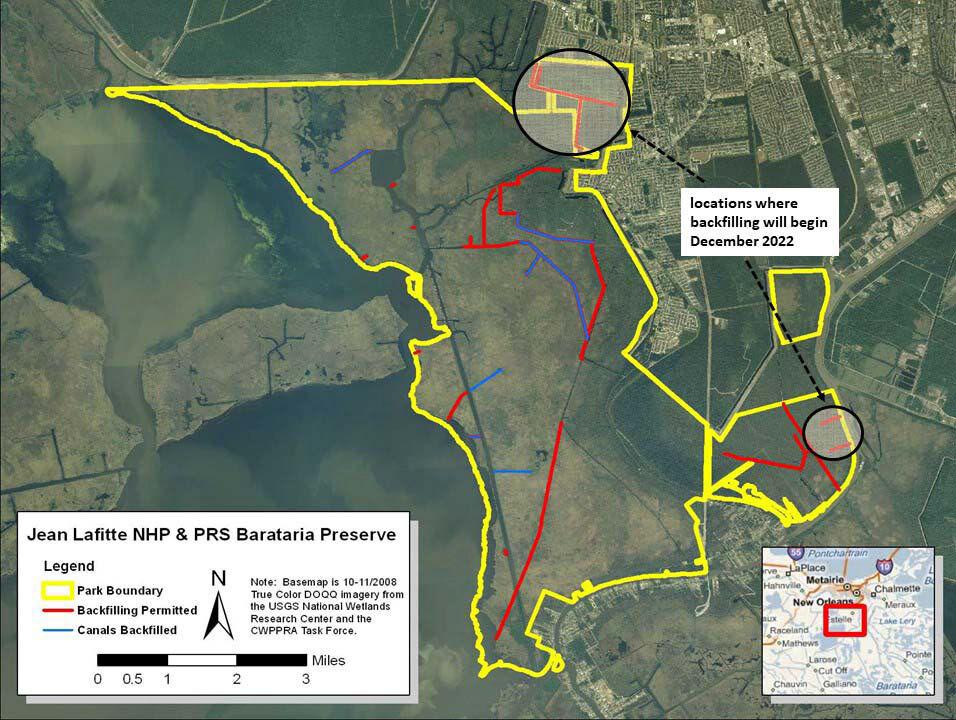
Hopefully this back filling of the Barataria Preserve will bring water back.
Just under 13 miles of canals running through parts of the 26,000-acre Barataria Preserve, a unit of the Jean Lafitte National Historical Park and Preserve, will be backfilled in an attempt to restore natural water flows, beginning on Thursday, the National Park Service announced. The $8.7 million project will be paid for with a grant awarded to the Department of Interior in 2016 under the federal RESTORE Act, which governs the use of Clean Water Act fine money paid by BP and its drilling partners for environmental damage caused by the 2010 Deepwater Horizon disaster. The project was one of five given out that year under the spill restoration program for projects in Louisiana by a federal-state board overseeing RESTORE Act funds. The project was delayed for several years because of design and environmental monitoring issues, as well as the COVID-19 pandemic, said park service spokesman Guy Hughes. Inflation and design and cost considerations also resulted in the amount of canals being backfilled to be reduced from 16.5 miles to 12.75 miles. U.S. Aqua Sources, the contractor for the project, is expected to complete the work in about six months. Spoil banks that were built with material dredged during canal construction and deepening will be returned to the canals, along with any vegetative material growing on them.
nola.com

(National Park Service)
The desire is to change open water to marsh.
The plan is to get the open water canal areas to revert to marsh, swamp and shallow water habitat through natural processes, and to restore areas where the spoilbanks blocked the natural flow of water through wetlands. “We are excited to continue restoring more natural hydrology at the Preserve by backfilling canals,” said Lafitte Preserve ecologist Julie Whitbeck in a news release. “We anticipate this project will improve wetland and waterway health and resilience to increasing salinity and storm energy. We look forward to sharing what we learn by monitoring the environmental and ecological outcomes of this project with interested stakeholders and coastal stewards.” The various canal cuts through the preserve were built from the mid-1800s until the early 1980s. According to an environmental review, the biggest network of canals was cut through the Barataria area in Jefferson Parish from the 1950s into the 1980s to service oil and gas exploration efforts. Others were dredged as oil and gas pipeline corridors. Still others were dredged in the early 1970s as a source of sediment for construction of dikes designed to reroute drainage in an area that was planned as a residential development and is now within the preserve.
As usual the oil and gas companies walked away from the damage they caused.
None of the canals were reclaimed after oil and gas operations or development operations ended, and long-term effects on the area’s swamp and marsh resulted. The canals helped funnel saltier water into the fragile freshwater habitat, and the spoil banks became infested with invasive Chinese tallow trees, which prevented the growth of native plants relied on by native wildlife, according to that report. The park spent $1.6 million on earlier backfilling projects. Park officials said that during the new effort, a barge and marsh buggies will be active within the area, sometimes in view or hearing distance of the public. Park staffers are completing a baseline monitoring effort of current environmental conditions. After the backfilling is completed, additional assessments will be conducted of the project’s effects.
The Park Service also released other documents affecting Entergy.
The park service on Thursday also announced the release of a draft environmental assessment for the proposed demolition and rebuilding of 29 electrical towers along 2.6 miles of the 30-mile Entergy Louisiana LLC Golden Meadow-Barataria electrical transmission line, which runs through the preserve. The line, built in 1964, was damaged during Hurricane Zeta in 2020 and Hurricane Ida in 2021. Many of the structures within the preserve are just west of Bayou Segnette. Public comments on the environmental assessment can be submitted by Dec. 31, either online at the park service’s public comment website, Parkplanning – Entergy Golden Meadows-Barataria Electrical Transmission Line Rebuild, or by mail to 419 Decatur St., New Orleans LA, 70130. A copy of the assessment is available at the website.
I support the Park Service as they do good work with little money.

